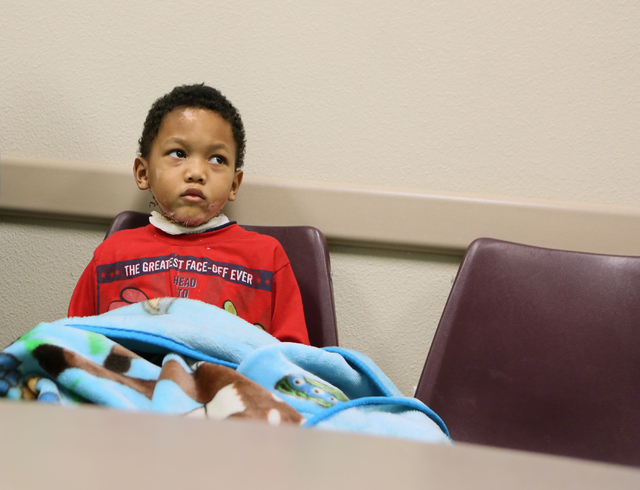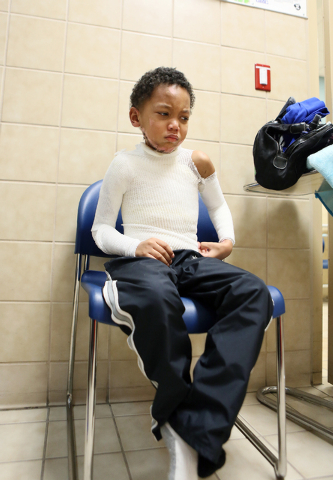Letters, toy monkey keep burned boy connected to classmates
It could have ended up as a cherished holiday remembrance — Grandma’s dog kept from harm by one of the youngest members of the family.
Yes, had everything gone the way little 7-year-old Anthony Fields figured it would during the visit to Grandma’s house three days after Christmas, his family would recount the caring in his soul, the kind of story proud parents repeat to anyone who will listen.
But on this February day at the University Medical Center outpatient burn clinic, Anthony anxiously awaits the re-dressing of severe burns that cover his upper torso — an excruciating process he endures daily. His mother finds it gut-wrenching to share how her firstborn tried to keep Grandma’s dog Mitch from getting hurt and instead became a human torch.
“He was just trying to get a barbecue lighter away from Mitch,” Manuela Ferreira says, choking back tears. “Anthony didn’t want him to get hurt and he got hurt instead. He was trying to be a good boy.”
It still isn’t entirely clear how the fire occurred, she says. What Anthony screamed to Grandma, as she smothered the fire with a blanket that enveloped his shirt as he ran for help, is that Mitch had a barbecue lighter in his mouth.
Anthony wrestled the lighter away from Mitch, but the dog apparently bit through the lighter, causing fuel to leak. Ferreira says her son told her that he tripped over Mitch and soon was on fire. He doesn’t remember pulling the lighter’s trigger.
If he hadn’t had the horrific accident that first kept him in UMC for more than a month — home rest is now often interrupted by less lengthy stays at the hospital for yet another skin graft — Anthony would be where he wants to be, with friends in Elizabeth Cox’s first-grade classroom at Warren Elementary School.
At least, he moans, barely audible as the itching of his burns causes him to squirm in his chair, “Anthony Junior is there.”
Anthony Jr., it turns out, is a stuffed toy monkey named in Anthony’s honor by his classmates. Always sitting in Anthony’s chair with a backpack securely in place, the toy is part of a program called Monkey in My Chair, which was originally developed as a way to maintain social interactions with classmates for youngsters out of school for cancer treatment.
The program, adapted by UMC child life specialist Kimberly Grettum for use with pediatric burn patients, ensures that an essential link remains between a burn survivor and the classroom as he struggles to get back to normalcy. Classmates regularly fill the monkey’s backpack with messages, letters and pictures that either Grettum or Cox deliver to Anthony.
“The first time I saw Anthony laugh after the accident is when a classmate sent him a picture showing the monkey sitting in his chair,” Ferreira says. “He said, ‘No monkey is going to take my chair.’
“This program is so important because it keeps him in touch with his friends. It really means something to him that they say they miss him and want him back. He looks really forward to the letters and pictures. One boy wrote that Anthony Jr. talks too much, just like Anthony did. What the kids tell him seems to lift his spirits more than anything else.”
Grettum visits the school once a week for about an hour to talk about Anthony’s recovery as well as fire safety and health issues. His classmates now know for instance, that he needs several operations before doctors can make his skin just right, that he needs to eat plenty of fruits and vegetables so he can heal well.
The children also know there are three degrees of burns and Anthony suffered the worst, third degree, the kind of burn where you need a skin graft, where skin is often taken from one part of the body to cover another.
“They were kind of confused by that and asked how I did that,” Grettum says with a smile as she recalls that a youngster seemed satisfied when she said she didn’t do it, but people trained to do it did. “You never know what they’re going to ask.”
As Grettum visits the elementary school recently, she says that because Anthony still has several operations to undergo, it might be some time before he gets back to class.
“I miss Anthony,” one of Anthony’s classmates tells Grettum. “Can’t the hospital hurry up?”
Grettum says, “He misses you, too. He wants to come back so bad but we have to get him all well first.”
In virtually every visit, Grettum asks the students what they should do if they see a lighter.
“They’re not for kids,” one child pipes up.
“Don’t touch it,” another chimes in.
“Leave it alone,” says another.
“That’s right, they’re for Mom or Dad,” Grettum says. “Go get Mom or Dad and make them keep it somewhere safe, so nobody can get hurt.”
As Grettum finishes updating the children, Cox says it’s time for the class to write another letter to Anthony and asks for suggestions. On a huge piece of paper on the board she begins with “Dear Anthony.”
One after another the ideas for the letter come in:
“Come back soon. … We want to play with you. … Eat good soup, chicken noodle. … We hope you get better really fast. … Eat good food, lots of fruit and vegetables. … Remember, Anthony, we really miss you. … Keep working, never give up.” Cox signs it “Love” and everybody comes up to sign it.
Cox, using a disposable camera, will take pictures of students and events at school to deliver to Anthony. On other days when Grettum visits, each child, under Cox’s careful eye, writes a personal letter. A couple of weeks ago Cox thought it wasn’t the proper time for one student to write Anthony, “Why didn’t you stop and roll when you were on fire?”
When she told the child such a question might make Anthony sadder, he understood.
“This program has taught the children a lot,” Cox says. “They’ve learned about how burns can affect them, how to write letters and get well notes, how to show you care.”
After Grettum leaves the school, she notes that Anthony will probably need years of psychological help.
His mother agrees.
“Anthony used to talk all the time and now he barely does,” she says as she sits next to her son in the burn clinic waiting room. “We have a teacher come to us now, but he misses the kids so much. Before this happened, he used to wrestle and play with his little brother, but now he has to be so worried about getting hurt.
“He’s just so sad now. It breaks my heart,” she adds. “That ‘monkey in the chair’ thing at least gives him some fun. But he needs help getting through this.”
The time comes for Anthony’s dressing change, a daily routine that causes grown men to scream in pain from just the air hitting their exposed burns, according to trauma surgeon Dr. Jay Coates. Anthony closes his eyes and holds his breath as his mother begins to undo the first of two shirts that cover his burns.
Already trying to be a man, he tries to lift his arm with only a grimace. But the tears start to flow. And then the 7-year-old who’s said almost nothing for an hour asks a question with the weariness of a wounded soldier on the battlefield.
“Why does there have to be so much pain?”
Contact reporter Paul Harasim at pharasim@reviewjournal.com or 702-387-2908.

































